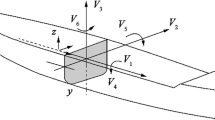Abstract
In the present analysis, several parameters used in a numerical simulation are investigated in an integrated study to obtain their influence on the process and results of this simulation. The parameters studied are element formulation, friction coefficient, and material model. Numerical simulations using the non-linear finite element method are conducted to produce virtual experimental data for several collision scenarios. Pattern and size damages caused by collision in a real accident case are assumed as real experimental data, and these are used to validate the method. The element model study performed indicates that the Belytschko-Tsay element formulation should be recommended for use in virtual experiments. It is recommended that the real value of the friction coefficient for materials involved is applied in simulations. For the study of the material model, the application of materials with high yield strength is recommended for use in the side hull structure.
Similar content being viewed by others
References
Alsos HS, Amdahl J, 2007. On the resistance of tanker bottom structures during stranding. Journal of Marine Structure, 20, 218–237. DOI: 10.1016/j.marstruc.2007.06.001
ASTM International, 2006. ASTM E18-15 standard test methods for rockwell hardness of metallic materials. ASTM International, West Conshohocken, USA.
Callister WD, 2007. Material science and engineering; an introduction, Seventh ed. John Wiley & Sons, Hoboken, USA, 359–364.
Haris S, Amdhal J, 2013. Analysis of ship-ship collision damage accounting for bow and side deformation interaction. Journal of Marine Structures, 32, 18–48. DOI: 10.1016/j.marstruc.2013.02.002
Kitamura O, 2002. FEM approach to the simulation of collision and grounding damage. Journal of Marine Structure, 15, 403–428. DOI: 10.1016/S0951-8339(02)00010-2
Lehmann E, Peschmann J, 2002. Energy absorption by the steel structure of ships in the event of collisions. Journal of Marine Structures, 15, 429–441. DOI: 10.1016/S0951-8339(02)00011-4
Minorsky VU, 1959. An analysis of ship collision with reference to protection of nuclear power ships. Journal of Ship Research, 3(2), 1–4.
Oxford Instruments Analytical, 2013. PMI-MASTER pro precise, mobile metal analysis. Oxford Instruments, High Wycombe, United Kingdom.
Ozguc O, Das PK, Barltrop N, 2005. A comparative study on the structural integrity of single and double skin bulk carriers under collision damage. Journal of Marine Structures, 18, 511–547. DOI: 10.1016/j.marstruc.2006.01.004
Ozguc O, Das PK, Barltrop N, Shahid M, 2006. Numerical modeling of ship collision based on finite element codes. International ASRANet Colloquium, Glasgow, United Kingdom.
Paik JK, Pedersen PT, 1996. Modelling of the internal mechanics in ship collision. Journal of Ocean Engineering, 23(2), 107–142.
Pedersen PT, Li Y, 2009. On the global ship hull bending energy in ship collisions. Journal of Marine Structures, 22, 2–11. DOI: 10.1016/j.marstruc.2008.06.005
Pedersen PT, Zhang S, 2000. Effect of ship structure and size on grounding and collision damage distributions. Journal of Ocean Engineering, 27, 1161–1179. DOI: 10.1016/S0029-8018(99)00043-8
Simo JC, Laursen TA, 1992. An augmented lagrangian treatment of contact problems involving friction. Journal of Comp. Structure, 42, 97–116.
Stefancu AI, Melenciuc SC, Budescu M, 2011. Penalty based algorithms for frictional contact problems. Universitatea Tehnica Gheorghe Asachi din Iasi, 3, 54–58.
Tornqvist R, Simonsen BC, 2004. Safety and structural crashworthiness of ship structures; modeling tools and application in design, International Conference on Collision and Grounding of Ships, Izu, Japan.
Wiśniewski K, Kolakowski P, 2003. The effect of selected parameters on ship collision results by dynamic FE simulations. Journal of Finite Elements in Analysis and Design, 39, 985–1006. DOI: 10.1016/S0168-874X(02)00143-9
Zhang S, 1999a. The mechanics of ship collisions. PhD thesis, Technical University of Denmark, Lyngby, 1–2.
Zhang S, 1999b. The mechanics of ship collisions. PhD thesis, Technical University of Denmark, Lyngby, 8.
Zhang S, 1999c. The mechanics of ship collisions. PhD thesis, Technical University of Denmark, Lyngby, 196–197.
Author information
Authors and Affiliations
Corresponding author
Rights and permissions
About this article
Cite this article
Bae, DM., Prabowo, A.R., Cao, B. et al. Study on collision between two ships using selected parameters in collision simulation. J. Marine. Sci. Appl. 15, 63–72 (2016). https://doi.org/10.1007/s11804-016-1341-2
Received:
Accepted:
Published:
Issue Date:
DOI: https://doi.org/10.1007/s11804-016-1341-2




